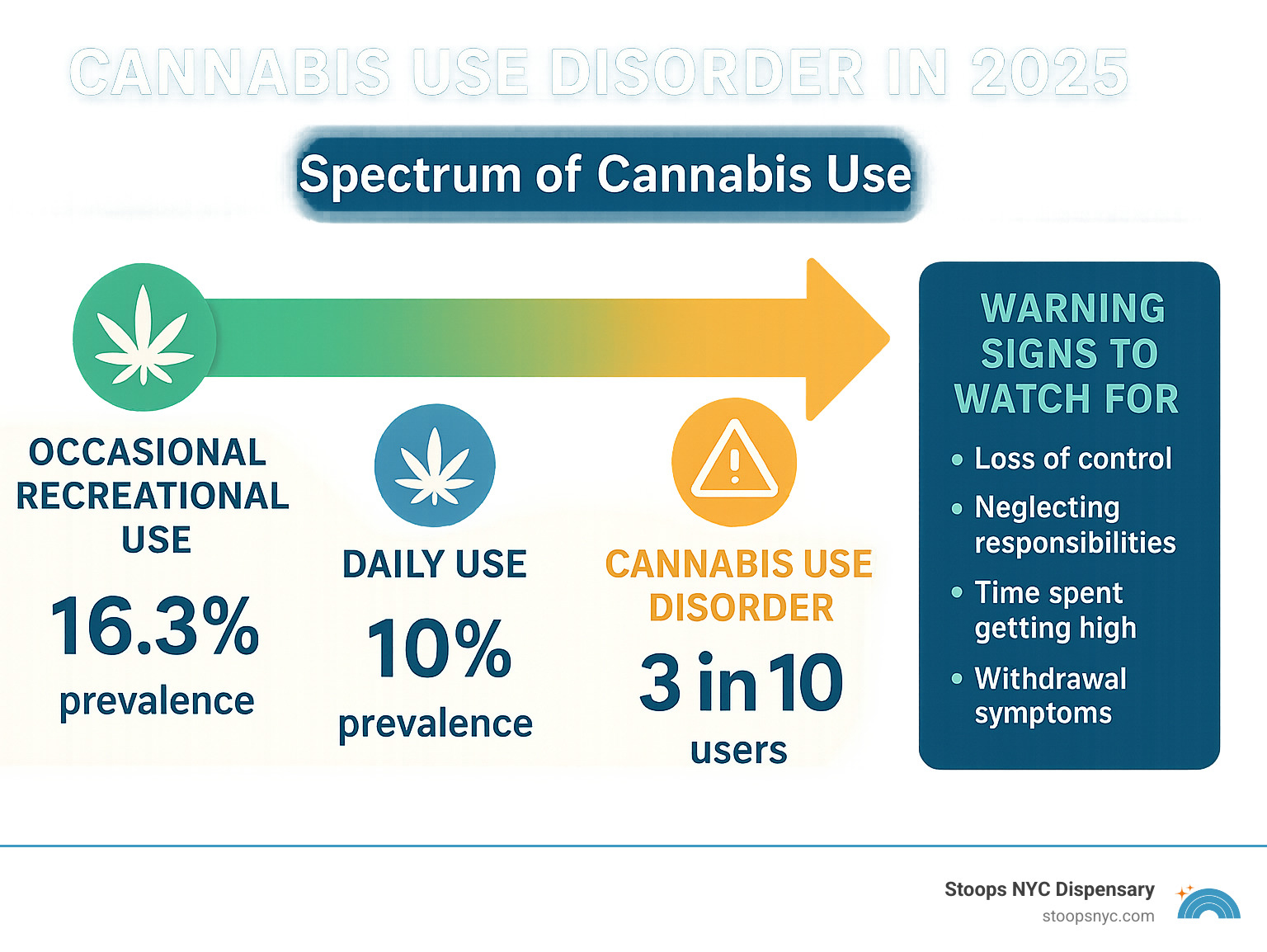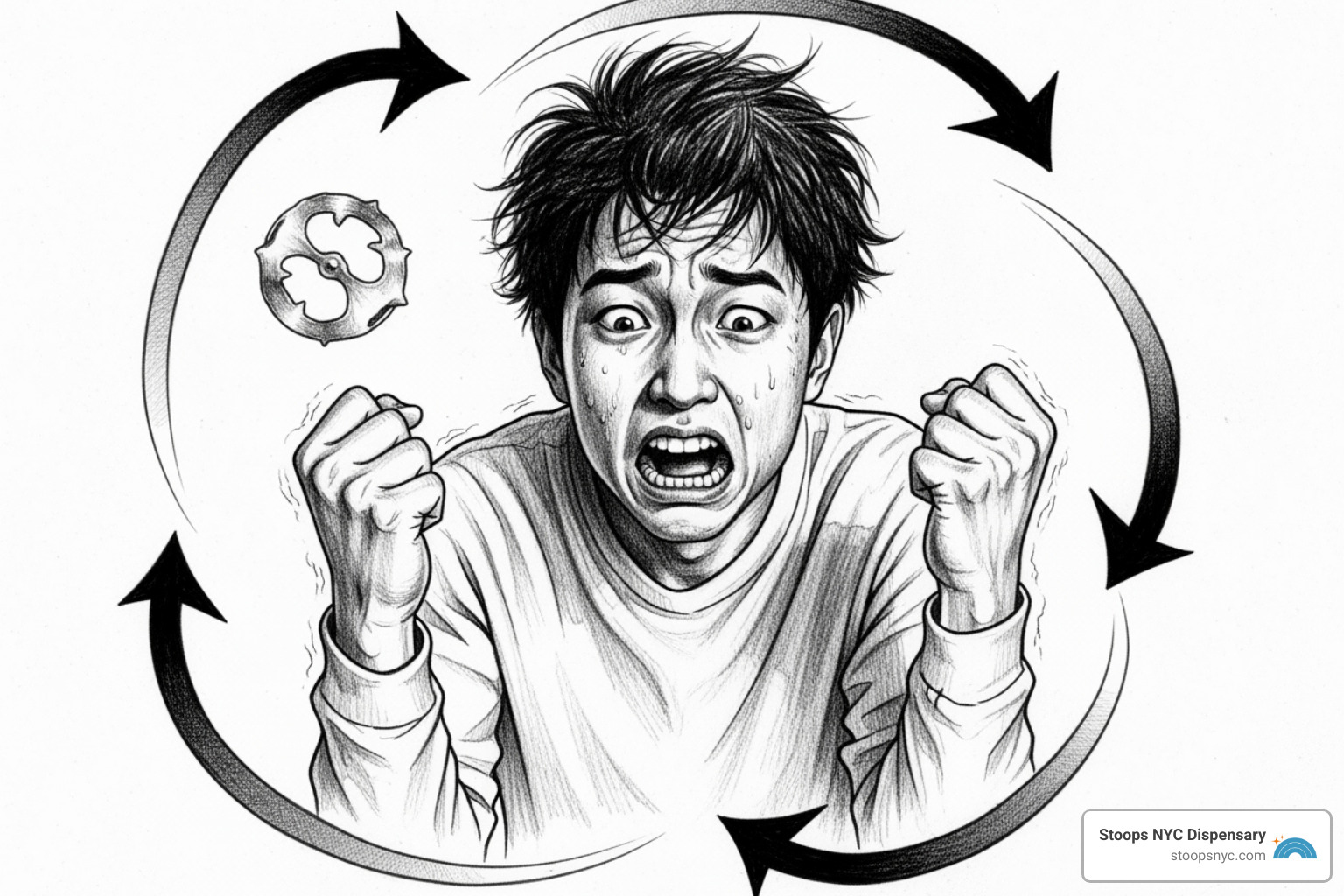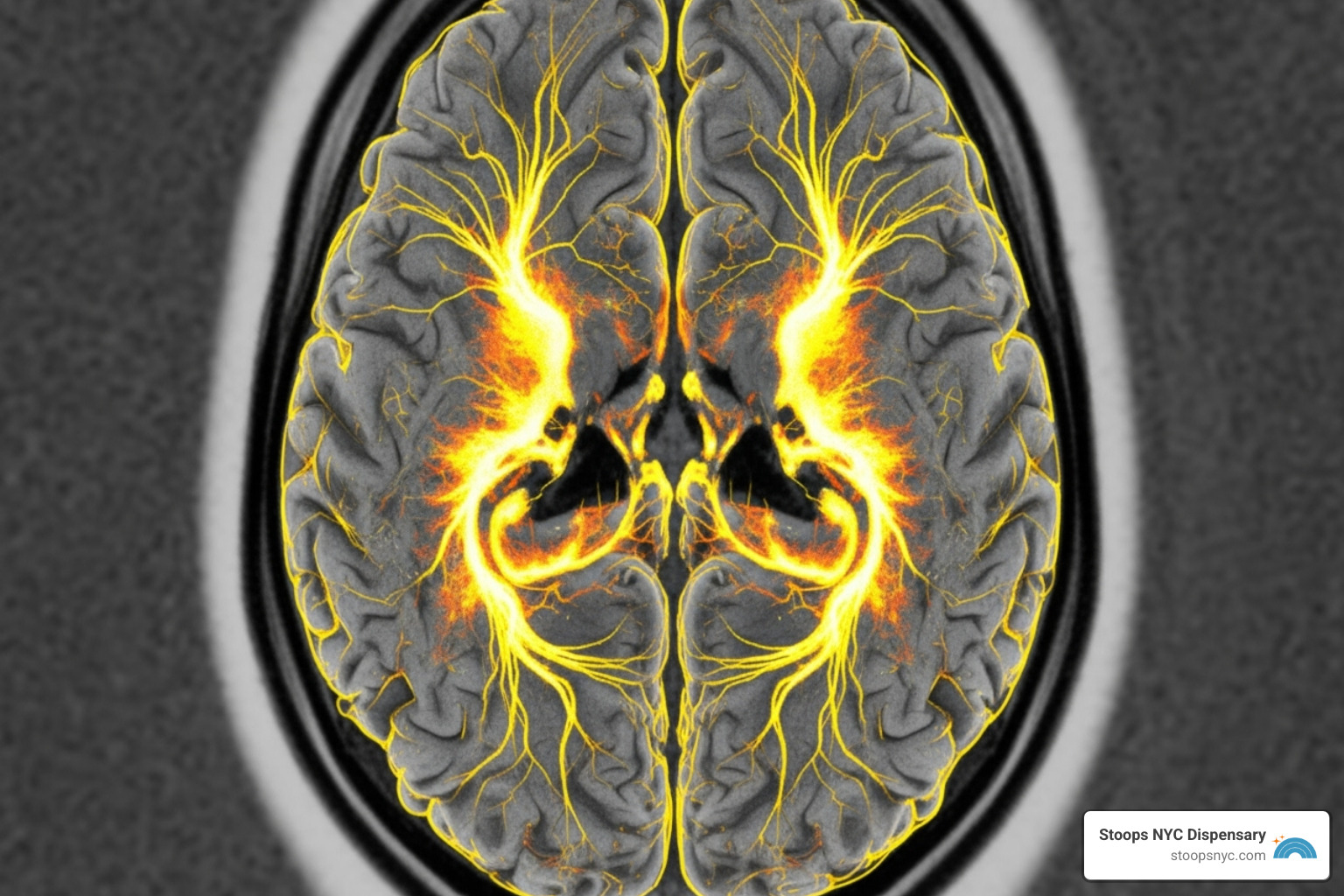Understanding Cannabis Use Disorder: When Cannabis Use Becomes a Problem
Cannabis use disorder is a medical condition where cannabis use continues despite causing significant life problems. It’s more common than many realize, affecting about 16.3 million Americans annually. While most people can use cannabis without issue, research shows that roughly 1 in 10 users will develop an addiction.
Quick Facts About Cannabis Use Disorder:
- Definition: A pattern of cannabis use causing distress or impaired functioning.
- Prevalence: About 3 in 10 cannabis users develop some form of the disorder.
- Risk Factors: Early first use, frequent use, high-potency products, family history.
- Symptoms: Loss of control, tolerance, withdrawal, neglecting responsibilities.
- Treatment: Available through therapy and professional support.
- Severity: Mild (2-3 symptoms), Moderate (4-5), Severe (6+).
With cannabis legal in New York, understanding the line between recreational and problematic use is crucial. A key concern is rising cannabis potency. Average THC levels jumped from 9% in 2008 to 17% in 2017, with some products exceeding 22% THC. Higher potency may lead to faster tolerance and more severe symptoms.
As Chris Kuilan, Co-Founder of Stoops NYC, I believe in promoting responsible use and education about cannabis use disorder. We are committed to helping our community understand both the benefits and risks.

Cannabis use disorder terms to remember:
What is Cannabis Use Disorder and How Common Is It?
Cannabis Use Disorder (CUD) occurs when cannabis use becomes problematic, negatively affecting a person’s work, relationships, and health. The American Psychiatric Association’s DSM-5 defines it as a pattern of use causing significant impairment in daily life. It’s not just about frequency but the impact on your well-being.
It’s useful to distinguish between dependence and addiction. Dependence is physical—your body adapts, leading to tolerance (needing more for the same effect) and withdrawal (discomfort when stopping). Addiction is a brain disorder involving compulsive use despite harmful consequences. CUD is a broad medical diagnosis that encompasses both concepts.
The severity of CUD is based on the number of symptoms experienced: mild (2-3 symptoms), moderate (4-5), or severe (6 or more). This recognizes that the disorder exists on a spectrum.
CUD is surprisingly common. In 2021, about 16.3 million Americans had the disorder. Among cannabis users, roughly 3 in 10 develop some form of CUD. The risk is higher for those who start young (about 1 in 6 for teens) and for daily users, whose risk can be as high as 25% to 50%, according to the U.S. National Institute on Drug Abuse.
Defining Problematic Use
Problematic use is marked by several key signs. The most significant is a loss of control, such as using more cannabis or for longer than intended. It also involves negative consequences, like missing work, straining relationships, or facing financial issues due to use. A defining feature is continued use despite harm—knowing it’s causing problems but being unable to stop. This often leads to impaired functioning, where obtaining and using cannabis takes precedence over hobbies, social events, and responsibilities. Finally, developing tolerance and withdrawal are clear indicators that use has become problematic.
How is Cannabis Use Disorder Diagnosed?
A diagnosis is made by a healthcare professional through a clinical assessment of your use patterns and their impact on your life. The diagnosis is based on meeting at least two of the 11 official DSM-5 criteria within a 12-month period. The number of symptoms determines the severity. While online self-assessment tools can be a helpful first step for self-reflection, they are not a substitute for a professional evaluation. A formal diagnosis is the first step toward getting effective treatment.
Recognizing the Signs: Symptoms of CUD and Withdrawal

Recognizing cannabis use disorder can be tricky because the signs often develop gradually. The DSM-5 outlines 11 specific diagnostic criteria to assess the problem’s severity. Meeting two of these within a year can indicate CUD. These criteria include using more cannabis than intended, persistent cravings, spending excessive time on cannabis-related activities, failing to meet responsibilities, continuing use despite problems, giving up important activities, using in risky situations, tolerance, and withdrawal.
Behavioral and Social Symptoms of Cannabis Use Disorder
The behavioral signs of CUD often start small. A key indicator is using more than intended or having unsuccessful attempts to quit or cut back. A person may find themselves spending significant time obtaining, using, or recovering from cannabis, while experiencing strong cravings that are difficult to ignore. Socially, this can lead to neglecting responsibilities at work, school, or home. Relationships may suffer as continued use creates tension, and the person might start giving up activities they once enjoyed in favor of using cannabis.
Physical Signs: Tolerance and Withdrawal
The primary physical signs of cannabis use disorder are tolerance and withdrawal. Tolerance means needing larger amounts of cannabis to get the desired effect, or noticing that the usual amount has a diminished effect. This can develop quickly with today’s high-potency products.
Cannabis withdrawal syndrome, recognized in the DSM-5, occurs when a regular user stops or cuts back. Symptoms typically begin within a week and can include:
- Irritability, anger, or mood swings
- Anxiety and nervousness
- Sleep disturbances, including insomnia or vivid dreams
- Decreased appetite or weight loss
- Physical discomfort like headaches, sweating, or abdominal pain
These symptoms, while temporary, can be intense enough to drive a person back to using cannabis for relief, perpetuating the cycle of use. You can find more information on cannabis withdrawal from NIH.
Why Does It Happen? Key Causes and Risk Factors

Cannabis use disorder develops from a complex interplay of factors, not a single cause. The process is often gradual. At a biological level, THC interacts with the brain’s endocannabinoid system and triggers dopamine release in its reward pathways. With regular, heavy use, the brain adapts, becoming less sensitive to cannabis and producing less of its own dopamine. This adaptation drives the cycle of tolerance and dependence that is central to CUD.
The Role of Genetics and Environment
Genetics play a significant role, accounting for 40-60% of the risk for any substance use disorder. A family history of addiction increases an individual’s vulnerability. Environmental factors are also crucial. Peer pressure, especially during adolescence, and easy access to cannabis can increase the frequency of use. Furthermore, many people use cannabis to self-medicate for co-occurring mental health conditions like anxiety, depression, or trauma. This can create a dangerous cycle where cannabis worsens the underlying condition while leading to CUD.
Key Risk Factors for Developing Cannabis Use Disorder
Certain factors dramatically increase the risk of developing CUD:
- Early Age of Onset: Starting cannabis use before age 18 makes an individual four to seven times more likely to develop CUD. The adolescent brain is still developing, making it more susceptible to cannabis’s effects.
- Frequency of Use: The more often you use, the higher the risk. Daily users face a 25-50% risk of developing CUD.
- High-Potency Cannabis: The strength of the cannabis product matters significantly.
How Cannabis Potency Impacts Risk
Today’s cannabis is much stronger than in the past. Average THC levels have nearly doubled, rising from 9% in 2008 to 17% in 2017, with some dispensary products being even stronger. High-potency products, including concentrates and edibles, can accelerate the development of tolerance and dependence. This increased potency also lifts the risk of adverse effects like psychosis, particularly in vulnerable individuals. The stronger the cannabis, the greater the risk for developing cannabis use disorder.
The Broader Impact: Health and Life Complications
When cannabis use disorder develops, its effects can extend into every area of a person’s life, impacting mental and physical health, relationships, and financial stability.
Psychological and Cognitive Effects
Chronic heavy cannabis use can interfere with brain function, leading to several cognitive issues:
- Impaired Memory: Difficulty recalling recent events or information.
- Attention Problems: Trouble concentrating or staying focused on tasks.
- Motivation Issues: A gradual loss of drive, sometimes called “amotivational syndrome.”
- Mental Health Risks: CUD can worsen or trigger conditions like depression and anxiety. It also increases the risk of psychosis, especially in those with a family history of mental illness.
Physical Health Complications
Despite being a plant, heavy cannabis use can harm the body:
- Respiratory Issues: Regular smoking of cannabis can lead to chronic cough, bronchitis, and lung irritation.
- Cardiovascular Strain: Cannabis can increase heart rate and blood pressure, posing a risk for those with heart conditions.
- Cannabis Hyperemesis Syndrome (CHS): A serious condition causing severe, recurring nausea and vomiting in heavy, long-term users.
- Fertility and Pregnancy: Use can affect fertility and pose risks to fetal brain development during pregnancy.
Social, Work, and Financial Problems
The real-world consequences of CUD are often what prompt people to seek help:
- Relationship Strain: Trust can erode as cannabis use takes priority over partners, family, and friends.
- Poor Performance: Cognitive effects can lead to declining performance at work or school, with adolescents being more likely to drop out.
- Legal Troubles: Issues can arise from impaired driving or possession, even in legal states.
- Financial Burden: A daily cannabis habit can become expensive, leading to debt and financial instability.
Finding a Path Forward: Treatment, Prevention, and Outlook for Cannabis Use Disorder
Recovery from cannabis use disorder is entirely possible. Effective treatments and support systems are available to help you regain control. The path to recovery is personal, and finding the right combination of support is key. Seeking help is a sign of strength.
Therapeutic Approaches and Support Systems
Effective treatment addresses the whole person, not just the substance use. Common therapeutic approaches include:
- Cognitive-Behavioral Therapy (CBT): Helps identify and change thought patterns and behaviors that lead to cannabis use, teaching practical coping skills.
- Motivational Improvement Therapy (MET): A client-centered approach that helps individuals explore their own motivations for change without judgment.
- Contingency Management: Uses tangible rewards to reinforce positive behaviors like abstinence or attending therapy.
- Support Groups: Groups like Marijuana Anonymous provide peer support from others with shared experiences, which can be a powerful tool for recovery.
- Family Therapy: Helps repair relationships and teaches loved ones how to support recovery effectively.
Treatment can occur in various settings, from outpatient counseling to residential programs, depending on the individual’s needs.
Are There Medications for CUD?
Currently, there are no FDA-approved medications specifically for treating cannabis use disorder. However, research is ongoing. In the meantime, doctors may prescribe medications to manage difficult withdrawal symptoms like anxiety or insomnia. Additionally, treating co-occurring mental health conditions like depression with appropriate medication is crucial, as it can remove a major trigger for cannabis use.
Prevention and Outlook
Prevention focuses on education and building healthy coping skills. Delaying the age of first cannabis use is the most effective preventive measure, as the adolescent brain is particularly vulnerable. For all ages, learning healthy ways to manage stress and life transitions can provide alternatives to using cannabis.
The outlook for cannabis use disorder is hopeful. It is a treatable chronic condition. While relapse can happen, many people achieve long-term recovery and go on to live fulfilling lives, whether that involves abstinence or a return to controlled, non-problematic use. Recovery is a journey toward greater freedom and better health.
Conclusion
As cannabis becomes more accessible in New York, understanding cannabis use disorder (CUD) is essential. CUD is a recognized medical condition, affecting about 3 in 10 cannabis users to some degree. It is defined not just by how often someone uses cannabis, but by the negative impact that use has on daily life.
Key risk factors include early age of first use, frequent consumption, and the rising potency of modern cannabis products. The consequences can be far-reaching, affecting cognitive function, mental and physical health, and social well-being. The most important takeaway is that recovery is possible.
Evidence-based treatments like Cognitive-Behavioral Therapy and peer support programs such as Marijuana Anonymous help people regain control. If you feel cannabis is causing problems in your life and you have trouble stopping, reaching out to a healthcare professional is a crucial first step.
At Stoops NYC in Manhattan’s Flatiron District, we are committed to promoting responsible use and providing our community with education and high-quality, lab-tested products. We welcome both first-time visitors and seasoned enthusiasts in a friendly, judgment-free environment.
Frequently Asked Questions about Cannabis Use Disorder
Can you get addicted to cannabis?
Yes. The clinical term for cannabis addiction is Cannabis Use Disorder (CUD). Research shows that about 1 in 10 cannabis users will develop the disorder. The risk rises to 1 in 6 for those who start in their teens and up to 25–50 % for daily users.
What’s the difference between cannabis dependence and CUD?
Dependence is primarily physical. It involves developing tolerance (needing more for the same effect) and experiencing withdrawal when use stops. Cannabis Use Disorder is a broader medical diagnosis that includes dependence but also encompasses compulsive use, loss of control, and continued use despite negative consequences. A person can be dependent without meeting the full criteria for CUD.
How do I know if I should seek help for my cannabis use?
Consider professional help if you:
- Experience negative consequences (work, school, relationships, finances, health) tied to cannabis use.
- Feel a loss of control, such as using more than intended or being unable to cut back.
- Develop tolerance or experience withdrawal symptoms.
Talking with a doctor or mental-health professional is a proactive way to assess your situation and explore support options.

